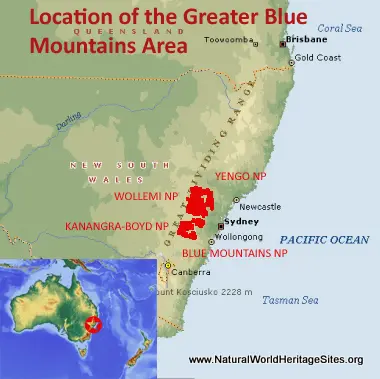EXPLORE Australia’s Greater Blue Mountains Area with this slideshow, check the location map and get all the facts and information below.
For slideshow description see right or scroll down (mobile). Click to view slideshow
Location and Values: The Greater Blue Mountains Area is located on the Australian Great Divide in New South Wales, inland from Sydney. The world heritage site covers eight contiguous protected areas dominated by temperate Eucalypt forest on a dissected sandstone tableland. It includes a wide variety of Eucalypt-dominated vegetation types typical of those that has evolved across most of the Australian continent, and ensures the protection of a significant representative area. Many of Australia’s iconic mammals – including koala, echidna and platypus, as well as grey kangaroo, red-necked wallaby, wallaro and wombat – are found in the area. From a biodiversity perspective the site covers a wide variety of habitats – wet and dry sclerophyll forests, mallee heathlands, localized swamps and wetlands as well as grasslands – and its flora includes some unusual ‘relict’ species of Gondwanan origin including the highly restricted endemic Wollemi Pine (Wollemia nobilis) and Blue Mountains Pine (Pherosphaera fitzgeraldii). Although it is included in the mountains category of this website, most of the table-land and its modest peaks lie below an elevation of 2,000m.
Conservation Status and Threats. According to IUCN’s most recent Conservation Outlook Assessment (December 2020) the conservation status of the Greater Blue Mountains Area has declined and is now considered to be of ‘significant concern’, following the severe fire season of 2019/20. The exceptional values which are recognized by the site’s inscription on the World Heritage List are now significantly threatened by:
- Fire. More than two thirds of the Greater Blue Mountains Area was subject to uncontrolled wild fires of varying intensity over a period of three months between December 2019 and February 2020. This has had a devastating impact on wildlife, and affected many of the outstanding attributes that contributed to the area’s world heritage listing.
- Climate change. This is resulting in extreme weather conditions including periodic drought, alternating with torrential downpours and floods. This is likely to affect the survival of some of the site’s unusual habitats (such as peat swamps and rainforests) and result in some reduction, alteration and die-off of moisture-dependent habitats.
- Private land enclaves and reserve configuration. The Greater Blue Mountains Area covers a complex of reserves that includes a large number of private land enclaves and a long external boundary. It is therefore exposed to threats arising from outside, including pollution of waterways from adjacent coal mines, runoff from urban areas, and fire risks from adjoining lands.
- Invasive alien species. Introduced alien species of plants and animals are displacing some of the naturally-occurring ones, including rare and threatened native species. Alien invasive plants are especially well adapted to colonise recently-burnt sites and are expected to thrive under the present post-fire conditions. Invasive species of animals include predators such as foxes and cats, as well as pigs, deer, goats, and carp (fish), all of which are impacting the native flora and fauna.
- Diseases affecting native plants and animals. A growing number of diseases are affecting populations of native plants and animals, including chlamydia in Eastern Rosella and King Parrots, chytridiomycosis in frogs and various plant pathogens. These pathogens affect populations of susceptible species and alter the makeup of the ecosystem.
- Inappropriate management. The recent fires have resulted in a re-assessment of past fire control measures which had allowed the build-up of excessive amounts of dead material, which resulted in very hot fires in this instance. Fire management policy will need to be revised to allow for more managed ‘cool’ burns on a more frequent basis within designated areas.
Links:
Google Earth
Official UNESCO Site Details
IUCN Conservation Outlook
UNEP-WCMC Site Description
Birdlife IBA
Slideshow description
The slideshow ‘tells the story’ of Australia’s Greater Blue Mountains Area with a portfolio of photos by Peter Howard from a visit to the Blue Mountains National Park in January 2018. Most of the photos are from the Kedumba sector of the park around Katoomba, taking in the views, flora and fauna seen at Sublime Point, Echo Point, the Valley of the Waters and Wentworth Falls. Further north, the slideshow features the National Parks and Wildlife Service Visitor Centre at Govetts Leap, views of the spectacular Pulpit Rock lookout, and two of the area’s unique endemic plants (Wollemi Pine (Wollemia nobilis) and Blue Mountains Pine (Pherosphaera fitzgeraldii)) that can be seen at the Blue Mountains Botanic Garden if not in their wild natural locations.
Factfile
Website Category: Mountains; Temperate & Boreal Forests
Area: 10,326 km2
Inscribed: 2000
Criteria:
- Ecological processes (ix);
- Natural habitat for biodiversity (x);





